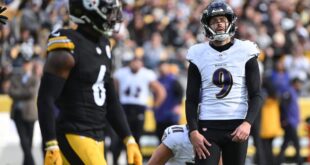Editor’s note: This article is part of The Changemakers series, focusing on the behind-the-scenes executives and people fueling the future growth of their sports.
LAKE ELMO, Minn. — When he retired from the Green Bay Packers, finally ready to leave the job that surpassed his wildest dreams, Mike Eayrs plucked folders from file cabinets and tried to figure out what he could actually take.
So many of the documents inside these folders were proprietary. Hundreds of printed spreadsheets, color-coded with highlighter yellows and electric greens, harboring the most detailed information you could possibly find about the NFL teams we all watch and love.
For decades, one of Eayrs’ many duties was creating these game-day cheat sheets for coaches. The laminated sheets of paper contained countless data points about every opposing coach: the play calls they preferred in certain situations, how their game plan would shift depending on the score and how quickly they’d typically unveil their plan during a game.
Walking away from his role as the Packers’ director of research and development nine years ago, Eayrs did not need any of these relics. Though he might be interested in a keepsake or two. Eventually, he grabbed one particular file, one he had compiled ahead of Super Bowl XLV, the Packers’ victory over the Pittsburgh Steelers.
“This is it,” Eayrs says, sliding it over.
Now 73, he is sitting at the kitchen counter in his home about 30 miles from Minneapolis. It’s a quaint spot. He lives here with his wife, Mary Jo. Their three children are out of the house now and have families of their own, so they have time to spend Sunday afternoons in August like this, relaxing and hosting a curious visitor.
Nothing about the appearance of Eayrs’ home hints at his former life as an NFL visionary, a man who is viewed by many as the grandfather of NFL analytics and referred to in hushed tones as the secret weapon in the Packers’ rivalry with the Minnesota Vikings. There are paintings on the family’s walls, no pictures memorializing Eayrs’ time on NFL sidelines. His wispy white hair and staccato voice make him rightfully seem like a blend of an engaging statistics teacher and an uplifting coach.
But then he scans through his keepsake and starts talking about the 2011 Steelers. How defensive coordinator Dick LeBeau played Cover 3 on 91 percent of their snaps in base personnel, and how the Packers used this tidbit of information to their advantage. The data is complex and contextualized, compiled to support the Packers’ coaches in making in-game decisions.
That’s how Eayrs viewed his role, first with the Vikings, then with their enemies to the east — as decision support. He did not set out to work in what is now widely known as “analytics.” In fact, when Eayrs stumbled into all of this in the 1980s, there was really no such thing as sports analytics. Why he was hired in the first place, how his job evolved over time and how he adapted to the changes are lessons about data science and quantitative analysis, a subset of NFL front offices that has become increasingly more prevalent.
“Mike was a lone ranger,” says former NFL coach Brian Billick, who won a Super Bowl as coach of the Baltimore Ravens. “He was theorizing some of the stuff we talk about now 40 years ago. He was so far ahead of the curve. He was brilliant.”
Before they built a sleek practice facility in the Twin Cities, the Vikings held training camp in Mankato at the local college. After practice, the Vikings coaches often crossed paths with the Minnesota State coaches. Once, in the early 1980s, the college’s head coach suggested some of the Vikings coaches sit down with one of his assistants, Mike Eayrs.
Soon after, Vikings assistants Les Steckel and Floyd Reese cast a shadow in the doorway of Eayrs’ office. They asked if they could talk, and Eayrs nodded nervously. They told him what they’d heard, that Eayrs had been studying regression lines and standard deviation charts relating to football.
Pulling up chairs across from Eayrs’ desk, one of them said: “Show us some of the things you got.”
Eayrs sifted through some papers, wondering where to start. He began as simply as possible. He explained that Minnesota State had gone 3-7 the year before and that he had watched the film of all 10 games, trying to identify patterns in the wins and losses.
“The thing that emerged right away was ball security,” Eayrs told them. “We threw interceptions and fumbled the ball.”
Steckel and Reese didn’t see this as much of a revelation. Even then, coaches knew turnover margin correlated with wins and losses.
So Eayrs took a different approach. Wanting to make the conversation more interactive, rather than acting like a know-it-all math person speaking to two experienced football people, Eayrs asked, “Do you know how long the average possession is?”
Reese, a defensive coach, replied, “You get a lot of three-and-outs.”
Steckel, the offensive coach, interjected, “But there’s a lot of 10-play drives, too.”
“In a way, both of you are right,” Eayrs said. “The mean number of plays in a drive is 5.8. (Nearly 40 years later in 2024, the average number of plays per drive is 5.71.) I’m the offensive play caller. I tell myself every time we take the field, I’ve got to have a plan in my mind of how we’re going to get from where we’re starting to scoring position in six plays or less.”
“Why do you do that?” Steckel responded.
In an instant, the coaches had gone from skeptical to curious. Maybe the most interesting aspect of their earnest interest was the fact that Eayrs was talking like a coach. It was as if his being a play caller earned him immediate credibility.
“If you look at the three games we won,” Eayrs said, “what happened was, somewhere in that possession, we had a long gain. Your goal as a play caller is to empower your men to set the circumstances up to get the big gain.”
In a nonintuitive way, he was explaining the impact of explosive plays on wins and losses.
Eayrs then asked them how much their play calling changed depending on the score of the game. Did they account for score differential when scouting their opponent’s tendencies?
Steckel and Reese looked at one another before shaking their heads: “No.”
“You’re missing one of the most important variables of the game,” Eayrs said. “The score has a distinct relationship with strategy.”
This back-and-forth continued for over an hour until Steckel and Reese realized they were about to miss practice. They asked Eayrs if he would show up at the high-rise dormitory on campus later that night. Eayrs ultimately did, and when he got there, another handful of Vikings coaches had come to meet him. They asked thoughtful questions that got Eayrs thinking about additional studies he could do. He left inspired.
Over the next few years, Eayrs compiled data packets and sent them to NFL teams. Legendary Dallas Cowboys executive Gil Brandt called him to ask about the information. Lou Holtz, then the head coach at the University of Minnesota, invited him to a meeting and asked, “What are you trying to do with this?” Eayrs told him he hoped to establish a consultant business so he could take his family on a nice vacation. “You keep producing these tables with numbers,” Holtz said, “and before you’re done, you’ll take your family on the greatest vacation you’ve ever known.”
A couple of years later, in June 1985, the Vikings did the inevitable. At the urging of the coaching staff, they hired a man who had neither played nor coached in the NFL. To do what exactly? At the time, Eayrs didn’t fully know.
What is an explosive play? @jasonjwilde‘s 2001 profile of former director of research Mike Eayrs revealed Green Bay counted:
• Passes over 16 yards
• Runs over 12 yardsMore: https://t.co/NU8haSIl4d pic.twitter.com/XRgN7TNW90
— The Power Sweep (@ThePowerSweep) January 23, 2019
Growing up, friends peppered Brian Eayrs: What does your dad do for the Vikings?
Brian would be lifting books out of his locker, and he’d hear the questions from classmates.
Is he a coach?
“Kind of,” Brian would say.
Is he a statistics guy?
“Kind of,” Brian would say.
What do you mean … kind of?
“He’s a statistics assistant for the coaches,” Brian would say, then leave it at that.
Eayrs’ job evolved over time. In 1985, his first season with the Vikings, the defensive staff was developing a new package. The coaches argued constantly, but a consensus formed around the information Eayrs presented: If teams were running a toss sweep more than any other play, why not design the package around limiting the toss sweep?
In general, legendary Vikings coach Bud Grant despised data. Eayrs initially printed packets of information and placed them on Grant’s wooden desk. Grant rarely acknowledged Eayrs’ insights in the early days, so Eayrs dipped into his own backstory, to what had intrigued him about football data in the first place.
When he was hired at Minnesota State in Mankato, Eayrs was asked to teach a class nobody else wanted to teach: statistics. The subject bored students some and the professors more. Eayrs thought he’d be a better fit for a leadership course or some psychological field relating to problem-solving. But he didn’t have a choice. From the outset, he vowed to find a textbook that did not read like rocket science, one that would allow the students to apply the subject to something fun like sports.
The class was segmented into groups, and each later presented its findings. One group studying the NFL discovered that the standard deviation curve was abnormally high in the middle with two long tails at the end. According to Eayrs, that meant there were 26 similarly talented teams clustered in the middle, and there were three outliers on both ends of the spectrum.
“What I used to tell the coaching staff in our meetings was, ‘You can be an optimist, or you can be a pessimist,’” Eayrs says. “Basically, if you’re an optimist, we’re sitting in this room, and we only have to figure out how to make eight to 10 crucial plays at the right time, and we’re going to be in the playoffs. And if you’re a pessimist, we are eight to 10 plays away from the abyss. The difference in that middle spectrum of teams really boils down to who can do the right thing at the right time.”
While the early studies shaped Eayrs’ perspective of the NFL, it also helped him connect with Grant. The simpler the information he could disseminate to Grant and the more he could align it with Grant’s coaching priorities, the more he believed Grant would listen. So he exchanged tables and charts for quick bullet points and, soon after, Grant started to knock more frequently on his door.
“Have you got a minute?” Grant would ask.
“What was I going to say to Bud Grant? No?” Eayrs says now.
Once, Grant sat across from Eayrs’ desk and said, “You know, we put an awful lot of work into practice. But I don’t really think we’re practicing as efficiently as we could. Is there anything you can think of that would help us?”
Eayrs thought silently.“We could start to record more information,” he suggested.
“Good idea,” Grant said, then stood and exited.
His mind racing, Eayrs wondered: How? And what? How would they measure practice, and what should they measure? He sketched out some ideas, utilizing a spreadsheet he’d already created for game day as a foundational resource. At the time, play-by-play data had not yet been automated. So, Eayrs decided he and a handful of assistants would jot down the plays called during practice, the defensive fronts used, the coverages deployed and the results of the play.
Almost a decade later, when Billick was hired as the Vikings’ offensive coordinator, he asked Eayrs to use a stopwatch to track the time between a snap and throw. By then, Brian Eayrs was a teenager, visiting the Vikings’ facility and burying himself in a dark room with his father while they charted practice reps together. Brian watched coaches enter the room and ask his father questions, then he listened to his father’s deliberate responses. It was almost as if Eayrs was having to convince the coaches to use his information.
But many of them did. And when they did, Brian was paying attention from section 131 at the Metrodome, wearing purple and grateful to be so close to his childhood team.
In 2001, the Vikings hosted the Packers at the Metrodome, but that night, Brian was not sitting in section 131. He had been sequestered in an end zone section surrounded by green and gold.
“That was the most eerie game of my life,” he says. “It was very strange.”
His father had made a change. After 16 seasons with the Vikings, Green Bay hired him away. Head coach Mike Sherman wanted someone who could gather, organize and filter information and help the Packers make better in-game and off-field decisions. Sherman said most folks within the NFL during the early 2000s knew how far ahead of the curve Eayrs and the Vikings were.
“So,” Sherman says, “we stole him away.”
Sherman remained the head coach until 2005. Mike McCarthy was hired a year later and not only kept Eayrs on, but also asked him, specifically after Green Bay’s 6-10 season in 2008, to bury himself in business strategy. Why? To find out if there were any approaches they could take and adapt to help the football side of the organization evolve.
Eayrs identified two relevant examples. The first was a study produced by the now-defunct Bemis Company, which transformed its strategy to offer more autonomy to its employees in the factory. The second was a report from Southwest Airlines explaining that its customer service was enhanced by providing gate attendants the ability to issue refunds to passengers. After months of research and planning, Eayrs presented his findings to McCarthy and the Packers staff.
Essentially, he believed the more the players on the field controlled the decision-making, the better off Green Bay would be. He even referenced an old Grant line, saying that decision-makers should come from the middle of the field. Offensively, quarterback Aaron Rodgers developed hand signals. Defensively, linebacker A.J. Hawk designed quick word association methods of changing the call from one to another.
“We never told the players about Bemis or Southwest Airlines,” Eayrs says. “They never knew the backstory.”
So much of Eayrs’ work was like this — unknown and never written about, but resoundingly impactful.
Mike Eayrs Green Bays Director of Research and Development spent 16 years with Vikings the last 12 with Packers.Gives GB huge inside edge.
— Larry Fitzgerald Sr. (@FitzBeatSr) December 3, 2012
Once, Eayrs applied a standard deviation curve to a 16-game NFL season and found that 10 to 12 games go like the staffers think they will, and there are two games on opposite ends of the spectrum that wind up as outliers due to injuries, turnovers or a flipped game script. He calls the negative games “Twilight Zone” games where “you’re going to see the train coming down the tracks,” Eayrs says, “and you’re going to try to do everything you can to divert it. You can’t.”
Another time, he used decades of practice data to answer the question of which drill most correlates with game results. The answer shocked him: seven-on-seven.
Eayrs’ curiosity could have kept him going forever. Even after he retired in 2015, Pro Football Focus hired him as an analyst to help the company make use of its swaths of automated data. Holtz would be happy to know that Eayrs’ family has taken numerous trips in the last decade.
You might not be surprised to find out that Brian’s kids are now getting the questions he once did: Is your dad a coach? Or is he a statistician?
Brian joined former Seattle Seahawks head coach Pete Carroll’s staff in 2013 and is currently helping first-year head coach Mike Macdonald. Data is more accessible now than it was when his father did the job, and Brian’s coding ability only multiplies what’s possible. Still, Brian believes that the core of what he and other analytics staffers across the league can offer is not like Jonah Hill in “Moneyball,” but more like the real-life Mike Eayrs. He was a man without answers who spent his entire work life trying to find them.
The Changemakers series is part of a partnership with Acura.
The Athletic maintains full editorial independence. Partners have no control over or input into the reporting or editing process and do not review stories before publication.
(Top photo: Charlie Riedel / Associated Press)
 meganwoolsey Home
meganwoolsey Home





